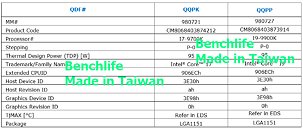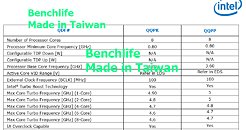- Joined
- Oct 9, 2007
- Messages
- 47,753 (7.42/day)
- Location
- Dublin, Ireland
| System Name | RBMK-1000 |
|---|---|
| Processor | AMD Ryzen 7 5700G |
| Motherboard | Gigabyte B550 AORUS Elite V2 |
| Cooling | DeepCool Gammax L240 V2 |
| Memory | 2x 16GB DDR4-3200 |
| Video Card(s) | Galax RTX 4070 Ti EX |
| Storage | Samsung 990 1TB |
| Display(s) | BenQ 1440p 60 Hz 27-inch |
| Case | Corsair Carbide 100R |
| Audio Device(s) | ASUS SupremeFX S1220A |
| Power Supply | Cooler Master MWE Gold 650W |
| Mouse | ASUS ROG Strix Impact |
| Keyboard | Gamdias Hermes E2 |
| Software | Windows 11 Pro |
Taiwanese tech site BenchLife.info scored finer details of Intel's upcoming premium LGA1151 processors through screenshots of leaked documents; revealing more about the Core i7-9700K 8-core/8-thread processor, and the top-dog 8-core/16-thread Core i9-9900K. The i7-9700K has the QDF number QQPK, and the i9-9900K "QQPP." The tables below also reveal their extended product code, CPUID, and iGPU device ID. There's also a confirmation that the TDP of both parts is rated at just 95 W. The next table provides a great insight to the clock speeds of the two chips.
Both chips idle at 800 MHz, and have an identical nominal clock speed of 3.60 GHz. The two differ with their Turbo Boost states. The i7-9700K has a maximum Turbo Boost state of 4.90 GHz, which it awards to 1-core. As a reminder, this chip is the first Core i7 SKU ever to lack HyperThreading support. 2-core boost frequency for this chip is 4.80 GHz. 4-core boost is up to 4.70 GHz. 4.60 GHz is the all-core boost (cores 5 thru 8). The i9-9900K gives both 1-core and 2-core the highest boost frequency of 5.00 GHz (that's up to 4 threads). The 4-core boost state is 4.80 GHz, and all-core (cores 5 thru 8) get 4.70 GHz. Intel is keeping its boost states rather high for this round of processors, as it tries to compete with the Ryzen 7 "Pinnacle Ridge" series.


View at TechPowerUp Main Site
Both chips idle at 800 MHz, and have an identical nominal clock speed of 3.60 GHz. The two differ with their Turbo Boost states. The i7-9700K has a maximum Turbo Boost state of 4.90 GHz, which it awards to 1-core. As a reminder, this chip is the first Core i7 SKU ever to lack HyperThreading support. 2-core boost frequency for this chip is 4.80 GHz. 4-core boost is up to 4.70 GHz. 4.60 GHz is the all-core boost (cores 5 thru 8). The i9-9900K gives both 1-core and 2-core the highest boost frequency of 5.00 GHz (that's up to 4 threads). The 4-core boost state is 4.80 GHz, and all-core (cores 5 thru 8) get 4.70 GHz. Intel is keeping its boost states rather high for this round of processors, as it tries to compete with the Ryzen 7 "Pinnacle Ridge" series.


View at TechPowerUp Main Site




 Be interesting to see how these compare
Be interesting to see how these compare 